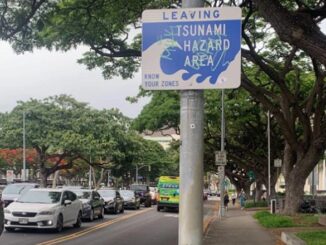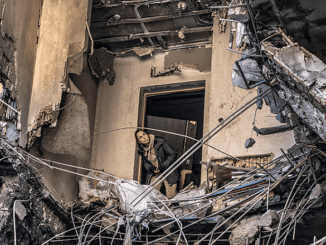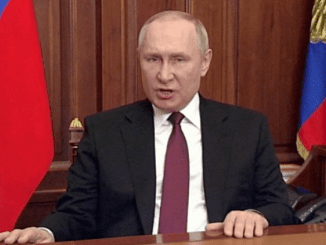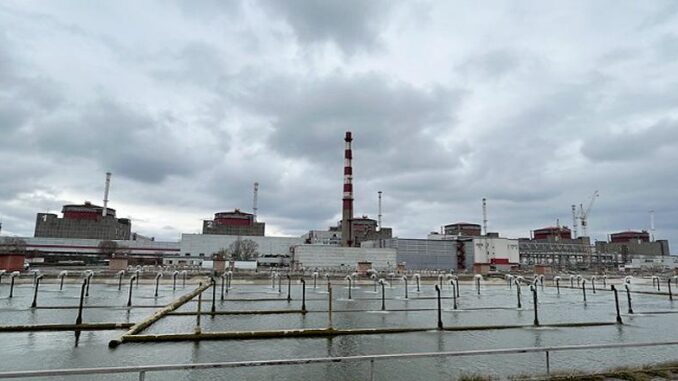
KYIV, Ukraine, June 13, 2023 (ENS) – Experts of the International Atomic Energy Agency are seeking access to a location near Ukraine’s Zaporizhzhya Nuclear Power Plant, ZNPP, to clarify the reason for a gap between different measurements of the water level in the reservoir supplying water to cool the facility’s six reactors and spent fuel storage.
IAEA Director General Rafael Grossi made the request today in a meeting with President Volodymyr Zelensky in Kyiv to discuss the risks posed to the Zaporizhzhia Nuclear Power Plant after the Kakhovka dam disaster one week ago.
The level of the Kakhovka Reservoir has been dropping rapidly since a big dam in the Russian-occupied town of Nova Kakhovka on the Dnieper River was severely damaged on June 6. Still, the Zaporizhzhya nuclear plant, also in Russian hands, reported over the weekend that the water level had been stable for about a day.
Those measurements were taken at the inlet of the Zaporizhzhya Thermal Power Plant, ZTPP, where water is pumped into a channel for use at the nearby nuclear power plant. This inlet is where the IAEA experts need to go.
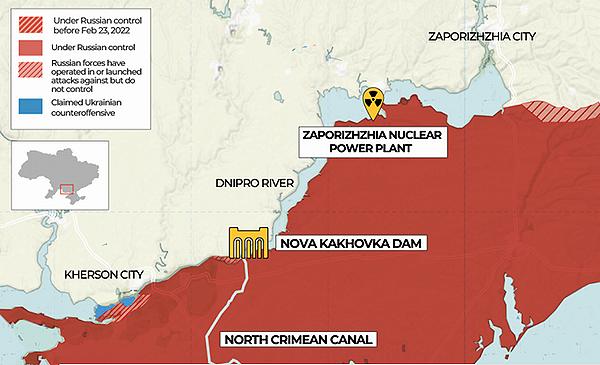
The height of the reservoir’s water level is a key indicator for continued operability of the nuclear plant’s water pumps. By 9 am local time today, the water level by the ZTPP was estimated at 11.27 metres, down from nearly 17 metres before the dam was breached, according to data received by the IAEA experts at the nuclear plant.
But, the IAEA points out, the water level continues to fall elsewhere in the huge reservoir, causing a possible difference of about two metres compared with the level reported by the ZTPP. This is the difference that worries IAEA Director General Grossi.
“It is possible that this discrepancy in the measured levels is caused by an isolated body of water separated from the larger body of the reservoir. But we will only be able to know when we gain access to the thermal power plant,” Director General Grossi said.
Grossi said on Monday that he would present an assistance program for the nuclear plant to Zelensky, survey the situation there, and conduct an expert rotation “with a strengthened team.”
Ukraine controls the western side of the Dnieper River, and Russia controls the eastern side. Kyiv and Moscow have each accused the other of deliberately damaging the dam, but neither side has produced proof. The hydroelectric power plant fed by water from the reservoir collapsed on Tuesday, sending floods of water rushing into the Dnieper.
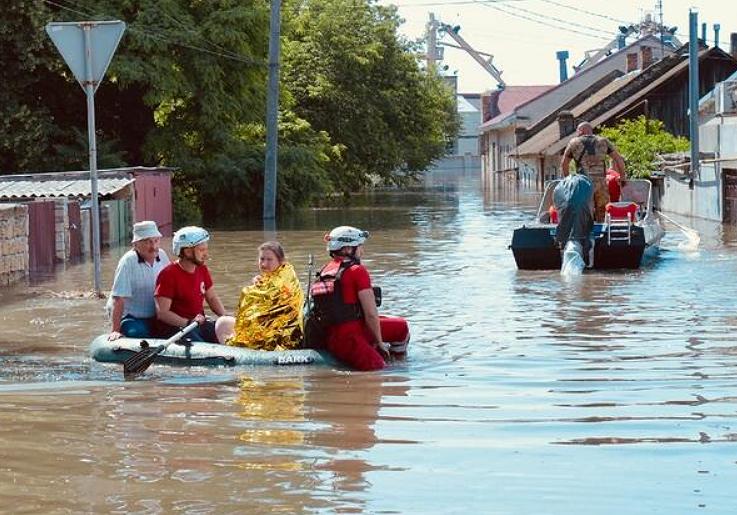
As rescuers work to save thousands of Ukrainians stranded on their rooftops by the flooding, Russians are shooting at them, Ukraine’s President Volodomyr Zelensky said today, while Kremlin spokesman Dmitry Petrov accuses Ukrainians of shooting into Russian occupied areas where people need rescue.
Before the dam was breached, the reservoir held more than 19 cubic kilometres of water. “Now, there are only 11 cubic kilometres of water left,” said Oleksandr Krasnolutskyi, Ukraine’s deputy minister of environmental protection and natural resources, told reporters at a briefing in Kyiv on June 8.
The reservoir provides water for more than 700,000 people in southern Ukraine. Cities on the Dnieper River, including Kherson, Nikopol, Marhanets and Pokrov, are short of water supplies, the United Nations warns.
According to Ukrainian authorities, the destruction of the Kakhovka Dam has flooded vast areas of agricultural land, submerged at least 80 communities in the Kherson region and displaced an estimated 17,000 people in government-controlled areas.
Nuclear Power Plant At Risk
In his meeting with Grossi, President Zelensky emphasized that the only way to ensure the safety of the Zaporizhzhia Nuclear Plower Plant was its demilitarization, de-occupation, and restoration of Ukrainian control, the President’s Office wrote.
Zelensky and Grossi discussed steps that can be taken to minimize the risk of incidents at the nuclear plant, the President’s Office reported.
Even though the Zaporizhzhya Nuclear Power Plant has not been producing electricity for several months now, it still needs access to water and power to avoid the risk of a potential fuel meltdown and release of radioactive material as well as for cooling and other essential safety and security functions.
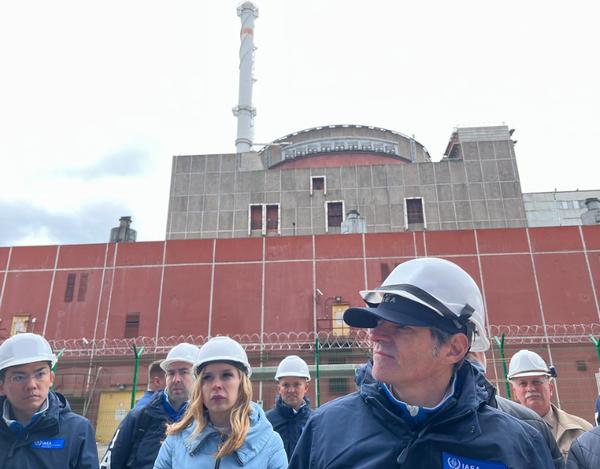
At the ZNPP, five reactors are in cold shutdown, while the sixth, unit 5, remains in hot shutdown to produce steam that supports processes contributing to safety on the site. The plant is considering the possibility of installing an independent steam boiler that would allow unit 5 to be put in cold shutdown while still meeting the need for steam supply to the site.
At the current height of the reservoir by the ZTPP, the water pumps continue to be operable. At the moment, however, they are not continuously being operated as both the ZTPP channel and the large cooling pond near the ZNPP are full, holding enough water reserves for several months of cooling requirements, the IAEA says.
The ZNPP cooling pond and the ZTPP discharge channel are both integral to continuing to supply cooling water, and Director General Grossi stressed again that maintaining their integrity is vital for the safety of the plant.
“The thermal power plant plays a key role for the safety and security of the nuclear power plant a few kilometres away. I fully expect that our experts will be able to go there very soon to independently assess the situation. I will also personally raise this important matter with the Zaporizhzhya Nuclear Power Plant,” Grossi said.
The Director General, who travels to Kyiv and the ZNPP this week, insisted that the IAEA requires access to the electrical switchyard of the ZTPP.
The ZTPP switchyard has in the past been used to provide back-up power to the ZNPP, but its last 330 kV line is still not available after being disconnected more than three months ago.
Europe’s largest nuclear power plant now relies entirely on its sole remaining 750 kV power line for off-site electricity, which has been cut repeatedly since the military conflict began in February 2022.
Featured image: Ukraine’s Zaporizhzhya Nuclear Power Plant relies on water from the Kakhovka Reservoir that was controlled by a large dam on the Dneiper River. That dam was breached on June 6, flooding the area and forcing thousands to evacuate their homes. (Photo by Fredrik Dahl courtesy International Atomic Energy Agency)
© 2023, Environment News Service. All rights reserved. Content may be quoted only with proper attribution and a direct link to the original article. Full reproduction is prohibited.

